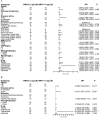Clinical characteristics and risk factors of ovarian reserve decreases in women with Crohn's disease: a case-control study
- PMID: 36750949
- PMCID: PMC9903622
- DOI: 10.1186/s13048-023-01112-6
Clinical characteristics and risk factors of ovarian reserve decreases in women with Crohn's disease: a case-control study
Abstract
Background: Crohn's disease (CD), often occurring in women of child-bearing age, can decline the fertility rate. However, whether it reduces ovarian reserve has been rarely reported. This study aimed to evaluate the ovarian reserve in women with CD from the perspective of anti-Müllerian hormone (AMH), and explore the factors that can decrease ovarian reserve.
Methods: A case-control retrospective study was designed. We analyzed the AMH levels in a total of 135 CD women and 878 healthy controls. Through propensity score matching, the subjects were assigned in a ratio of 1:3 to CD group (n = 121) and control group (n = 324). Both groups shared similar basic characteristics, like age, body mass index and smoking status. Serum AMH levels were measured by chemiluminescence.
Results: The AMH level in the CD group was significantly lower than that in the control group (2.17 ± 2.23 μg/L vs 3.95 ± 2.01 μg/L, 95%CI [1.34-2.21], P < 0.001). In both groups, the AMH levels decreased as age increased, but without between-group difference in the decreasing rate (P = 0.639). Multivariate analysis showed that age > 30 years (OR, 2.905; 95%CI [1.053-8.531], P = 0.017), disease activity (OR,4.314; 95%CI [1.561-12.910], P = 0.002) and thalidomide use (OR,12.628; 95%CI [4.351 -42.820], P < 0.001) were independent risk factors associated with decreased ovarian reserve (AMH<1.1μg/L).
Conclusion: Ovarian reserve is lower in CD women than in healthy women. Age, CD activity and medication of thalidomide are risk factors that can aggravate the decline of ovarian reserve.
Keywords: Anti-Müllerian hormone; Crohn’s disease; Ovarian reserve.
© 2023. The Author(s).
Conflict of interest statement
The authors declare no competing interests.
Figures
Similar articles
-
Ovarian Reserve Assessed by the Anti-Mullerian Hormone and Reproductive Health Parameters in Women With Crohn´s Disease, a Case-Control Study.Physiol Res. 2021 Nov 30;70(Suppl 1):S69-S78. Physiol Res. 2021. PMID: 35503052
-
Ovarian Reserve Assessed by the Anti-Mullerian Hormone and Reproductive Health Parameters in Women With Crohn´s Disease, a Case-Control Study.Physiol Res. 2021 Nov 30;70(Suppl 1):S69-S78. doi: 10.33549/physiolres.934776. Physiol Res. 2021. PMID: 34918531 Free PMC article.
-
Risk Factors Associated with Impaired Ovarian Reserve in Young Women of Reproductive Age with Crohn's Disease.Intest Res. 2020 Apr;18(2):200-209. doi: 10.5217/ir.2019.00103. Epub 2020 Mar 31. Intest Res. 2020. PMID: 32224833 Free PMC article.
-
Factors associated with decreased ovarian reserve in Crohn's disease: A systematic review and meta-analysis.Acta Obstet Gynecol Scand. 2024 Sep;103(9):1714-1721. doi: 10.1111/aogs.14853. Epub 2024 May 27. Acta Obstet Gynecol Scand. 2024. PMID: 38803058 Free PMC article.
-
Assessment of ovarian reserve by serum anti-Müllerian hormone in patients with systemic lupus erythematosus: a meta-analysis.Ann Palliat Med. 2020 Mar;9(2):207-215. doi: 10.21037/apm.2020.02.11. Epub 2020 Mar 3. Ann Palliat Med. 2020. PMID: 32156138 Review.
Cited by
-
Inhibin B and antiMüllerian hormone as surrogate markers of fertility in male and female Crohn's disease patients: a case-control study.Front Med (Lausanne). 2024 Apr 25;11:1374603. doi: 10.3389/fmed.2024.1374603. eCollection 2024. Front Med (Lausanne). 2024. PMID: 38725465 Free PMC article.
References
MeSH terms
Substances
LinkOut - more resources
Full Text Sources
Medical




